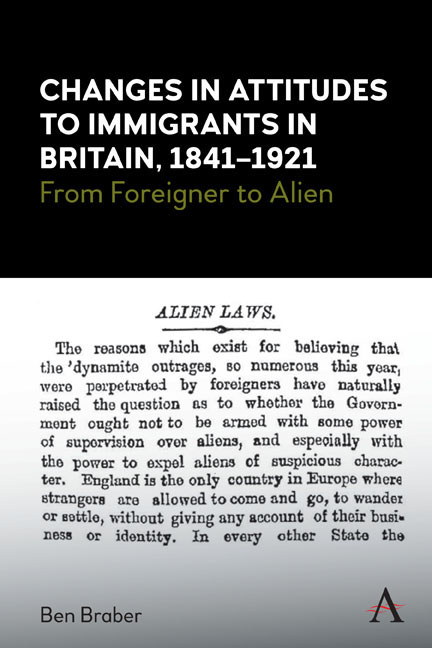3 - Qualitative Analysis of the Use of Alien
Published online by Cambridge University Press: 23 January 2021
Summary
In 1921, more people in Britain more often read the word alien than in 1841. This qualitative analysis determines how the use of alien in newspapers developed during this period, what it meant and which overtones it acquired.
The tables presented so far do not list separately the use of the word alien as a noun and as an adjective. As stated, the adjective alien can mean foreign, strange or different, distinct and opposed to, and may not be related to foreigners, strangers and aliens. To investigate this further, an advanced search in The Times for the string ‘alien’ has been made, with a manual check of all the articles found through this search, to determine the specific uses and meanings of alien. The results of that examination are listed in Table 9.
Table 9 shows that the paper only very sparingly applied alien as a verb, meaning to quarrel; a legal term for a specific action, meaning the transfer of property; a botanical term,1 meaning of foreign origin or growth; and a linguistic term, meaning borrowed from another language. The use of all these meanings together always constituted less than half a per cent of the total use in a specific period. The table also indicates that the use of alien as an adjective and noun meaning foreign(er) and strange(r) between 1841 and 1890 surpassed and after 1890 greatly exceeded the use of alien as an adjective meaning different, distinct and opposed to, which actually declined after 1890. The figures in Table 9 also enable the conclusion that the spectacular rise of alien in The Times after 1890 can be contributed to the application of this word to foreigners and strangers who were in Britain. And when the data in Tables 8 and 9 are combined, it is obvious that the rising uses of alien and immigrant coincided.
The data from Table 9 are graphically reproduced in Figure 4.
Figure 4 brings out the major trends in the use and meaning of alien in The Times between 1841 and 1920. Five periods can be distinguished:
1841–60 with little overall change;
1861–80 with a rise in the meaning of foreign(er) and strange(r) as well as that of distinct, different and opposed to;
Information
- Type
- Chapter
- Information
- Changes in Attitudes to Immigrants in Britain, 1841–1921From Foreigner to Alien, pp. 47 - 88Publisher: Anthem PressPrint publication year: 2020
